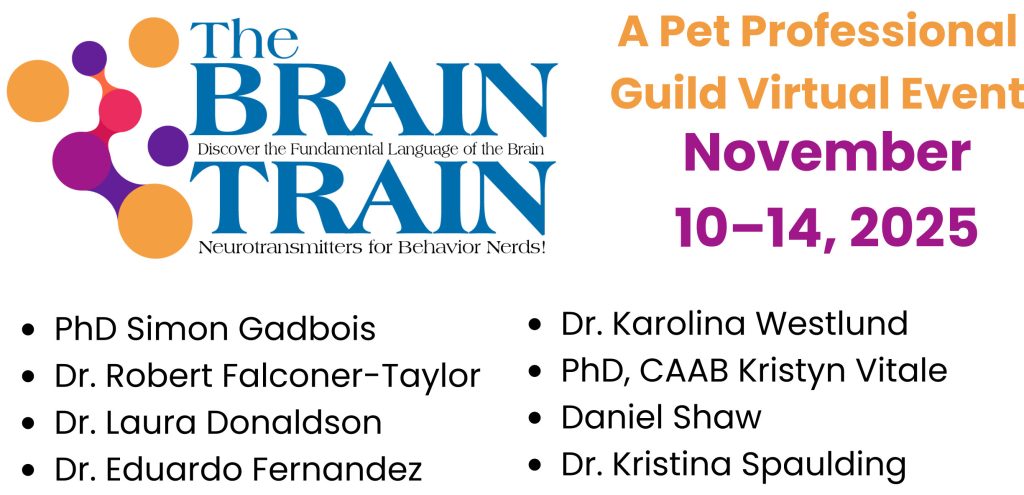Pet Guardians
Malena DeMartini: A Beacon of Light for Dogs Who Suffer When Left Home Alone
Malena DeMartini shares her personal and professional journey to creating her company that provides educational programs for dog professionals and guardians to help dogs with separation anxiety. Who are you, and what makes you passionate about animal behavior? I have been a professional dog trainer and behavior consultant for over two decades and had a beautiful introduction to animal behavior via my education through the Academy for Dog Trainers. Initially, I worked with all manner of dog behavior, from jumpy puppies to human-directed aggression. However, I developed an… Continued
Chat & Chuckle with Dr. Lisa Radosta of Florida Veterinary Behavior Service
Join Niki Tudge, PPG Canine Committee chair Judy Luther and BARKS Magazine editor-in-chief Paula Garber as they Chat and Chuckle with Dr. Lisa Radosta, owner of Florida Veterinary Behavior Service and co-owner of The Real Dog Nerds, about pets with behavior problems requiring a veterinary behaviorist, and what pet guardians can look for and do in preparation for and support of a veterinary behavior program for their pet. Listen to the Podcast with Dr. Lisa Radosta here on your choice of platforms. Or just stay on this page and… Continued
Scent Success: Giving Scent Work a Second Chance
Congratulations to Shelley Doane! This post won runner up in the 2022 Canine Scent Writing Competition. I started getting interested in canine scent work with my dogs a few years ago. It began with an introductory class taught by a fellow trainer. It was an interesting class with lots of good information, but I did not find it fun, and my dog, Sophie, didn’t seem to really enjoy it either. A couple of years later, I listened to a podcast by another trainer about scent work using food and how… Continued
The Harness Is Coming – Run for the Hills!
I often wonder why some of us expect our dogs to miraculously accept collars, harnesses, leashes, and the like. After all, dogs are not born with these alien contraptions attached to their person! But some of this gear must feel restrictive, worrying, anxiety-provoking, or even potentially painful. Especially without careful prior desensitization. Which Dog Gear and Why? There are many different bits of paraphernalia available out there right now, so think seriously about what you need and why you need it. Most importantly, think how it benefits your… Continued
Sniff for Calm and So Much More!
Congratulations to Kris Whipple! This post won first prize in the 2022 Canine Scent Writing Competition. Of all the canine behaviors that I teach, calm is the most valuable. Calm dogs are less likely to bark, jump, mouth, lunge, pull or engage in other challenging behaviors that come with overexcitement. For me and my dog Sprig, an exuberant adolescent Cardigan Welsh corgi who thinks every day (and experience, dogand person) is his best day EVER, sniffing has become a positive and powerful tool I use daily to promote calm behaviors… Continued
Dog Speak: The Language of Barking
At a recent public event I attended, the question asked most by companion dog owners was, “How do I get my dog to stop barking?” As professionals, of course, the first thing we want to do is ask more questions. “When does the dog bark?”, “What time of day?”, “What are they barking at?”, “What are they getting out of it?”, “What do you do when they bark?”, “What do you want them to do instead?” and so on. We can all think of people who talk too much yet no… Continued
Socializing Puppies to Other Animals
Dog guardians these days tend to be fairly aware of the crucial importance of socialization. These include the interactions a young puppy will have with people in his/her immediate family, people outside the family, and people of all different ages and appearances, wearing all sorts of strange outfits, carrying various novel objects (such as umbrellas or suitcases) etc. Guardians are often also aware of habituation. This means ensuring that the puppy begins to experience all sorts of adventures in her formative weeks and months that she will encounter in adult… Continued
The Impact of Canine DNA Testing: Mapping the Future
In May 2016, Embark launched its comprehensive pet genetic test in partnership with the Cornell University College of Veterinary Medicine. According to Embark’s website, the test will track “over 200,000 genetic markers, offering ancestry analysis as well as an extensive overview of both genetic disease risk and heritable traits, allowing users to understand their dog’s health, plan for his future and provide the best personalized care possible.” Embark further states that “four out of 10 dogs will suffer from inherited diseases,” and that the test, more than just a breed… Continued
Feline Fastidious Foodies
By Patience Fisher From cat food commercials to cartoons and internet cats, it is something of a running joke that cats are picky eaters. But is this common assumption correct? According to C.A. Tony Buffington, a leading researcher in the field of feline nutrition, the answer is a resounding no. Health and Stress Buffington states that cats are very adaptable; left to their own devices they can and do thrive on a wide range of foods. This is important to their survival, since they are opportunistic eaters. If a cat… Continued
Why Do Deaf Dogs Bark?
By Morag Heirs Barking is a form of communication for all dogs so it is important that we spend some time thinking about why our dogs might be barking. Are they anxious, over-excited, upset, fearful, thrilled, frustrated? Something else? Avoid concentrating on stopping the barking (particularly through the use of ‘aversives,’ e.g. telling off, harsh signals, water spray or air sprays, exclusion from the room or crating on a regular basis) as this gets in the way of understanding why the barking is happening. Without understanding why our dog is… Continued
The Value of Non-Verbal Communication
By Angelica Steinker Consent testing is an informal experiment which allows a dog to offer consent regarding a specific situation. Via her body language the dog communicates a yes or no response. This information is used to: • Improve the quality of life of the dog. • Improve a training plan. • Make behavior modification more effective. • Generally improve communication. The yes or no is determined by assessing the dog’s body language and observing for distance increasing or distance decreasing behaviors. Distance increasing behaviors are considered a “no” and… Continued
The Challenge of Breed Discrimination
By Kym Iffert It was finally a beautiful day in Chicago so I grabbed my bag, my leash, a pocket full of treats and tennis ball and set out for a walk. The neighbors were out and it was the perfect opportunity for a social outing – but not for me and my dog. As we walked down the sidewalk, others may have looked, some would wave, a few may have offered a smile… and then crossed the street. Social pariah? No, just me and my Rottweiler out for a… Continued
Thunder, Lightning and Barometric Pressure
By Carolyn Kocman Owners and caretakers can almost always recognize phobia related behaviors. Shaking, drooling, panting, restlessness, pacing, clinging to owners and hiding are all fairly overt and recognizable behaviors that can be triggered by such things as loud noises or thunderstorm activity. Immediate Recommendations for Panicking Dogs There are a number of things pet owners can do to comfort an animal that is in the throes of phobia related behavior. What follows is a list of more immediate recommendations. These are not tips on modifying the behavior and should… Continued
Pups and the Power of Positive Touch
Don’t you just love being able to have that closeness with your dog? The snuggling in, the mutual touch, and just really enjoying each other’s affection? But sadly it’s not always like this. Not all dogs enjoy or are comfortable with our advances or attempts to hug, stroke, pet, or cuddle them. This can be distressing, upsetting and frustrating for both parties, especially as many people love having a dog in their lives so they can benefit from that mutual affection. The Right to Interact? ‘Consent’ is a… Continued
Introducing Cats: Slowly Does It
By Patience Fisher There are many challenges for shelters in finding adoptive homes for cats. As an adoption counselor, I always found it disheartening to have a cat returned to the shelter for not getting along with the resident cats. During the adoption process, the concept of slow introductions was explained, but upon the cat’s return we often found out that the introduction process had been rushed. As a result, I saw a need for a very simple, short, how-to brochure for introducing a new cat to a resident… Continued
The Aftermath of “Boot Camp”
By Amanda Ballard [At the time of writing] Kobe is an 18-month-old terrier cross, who is loved madly by his person, Lizzie. My private consultation session with them is the only one in 10 years that has moved me to tears, right there in front of the owner. It absolutely broke my heart to witness a dog displaying visible signs of anxiety, triggered by hearing very basic and commonly used verbal cues. Sadly, it would not be the last time I would witness this. There is no doubt about… Continued
New Bird on the Block
By Vicki Ronchette Over the years I have introduced several parrots into my flock of companion birds. During this time I have found there are some things that should be done early on to help shape the bird into a good companion, while also giving him time and respecting his boundaries. I have talked to a lot of people who were disappointed that their new bird’s behavior changed after a couple of months in their home. Some people call this a “honeymoon period.” I do not use that term… Continued

I Pushed My Friend off the Sofa! Whoops… [How to deal with undesirable guest/animal interactions]
By Ryan Cartlidge I’m not proud of it, but recently I pushed a friend – who was staying at our house – off our sofa! Find out why below (as well as how to avoid doing it yourself) … This happened during the festive season, and if you are like us, you probably have lots of people coming to visit and/or stay at this time. So what do you do if these people (who might be strangers to your animals) come in and engage with your animals in ways… Continued
Compulsive Eating in Dogs
By Maureen Tay Also known as compulsive eating disorder, compulsive eating is a disorder where a dog tends to eat everything – from food items to non-food items. The specific practice of eating non-food, non-nutritive substances, such as wool or paper, is known as pica. Stool eating (coprophagia) can also be categorized under pica. Common among Puppies Puppies are curious animals. They eat just about anything they can find, including things that are inedible. Puppies love to investigate their surroundings. An excellent way to do this is for… Continued
Training a Blind Dog
By Miki Saito Unfortunately, even knowledgeable and experienced trainers sometimes hesitate when it comes to working with a blind dog. It is as if they consider the dog’s blindness an obstacle that cannot be overcome. Since blindness cannot be changed, this mindset can lead trainers to believe that these dogs cannot be trained but this is, of course, untrue. The dog’s blindness does not inhibit training. His emotional state, however, may be preventing him from having a positive learning experience. As explained by Dr. Jesus Rosales-Ruiz at the Clicker… Continued
What Puppy Toy Next?
By Anna Bradley If you’re anything like me, I absolutely love buying my dogs new toys. The look on their faces is pure joy and excitement when the novelty factor of a new toy kicks in – there’s nothing like it! But then they get bored after a while and are already waiting for their next toy – which duly arrives. That’s how well trained I am! But rather than simply (and randomly) buying loads of toys on a whim, I do think carefully about what to buy, based… Continued
Aggression from Hearing Impairment?
By Morag Heirs As any reputable behavior consultant will tell you, all animals presenting with a behavior problem should first be checked by a vet. As behavior consultants, we work on veterinary referral for a number of reasons. Firstly, we want to be sure that the problem is not a symptom of an underlying medical condition and, secondly, we may need to collaborate with the veterinary professionals if medication or supplements are needed to support the behavioral therapy. Sometimes we might receive a referral where the examining veterinarian has decided… Continued
The Rollercoaster of Reactivity
By Mary Jean Alsina Leash reactivity can be one of the most common (and embarrassing) problems dog owners deal with on a daily basis. It is also one of the most requested behavioral issues I work on with clients. Disapproving glances from passersby, the constant feeling of being out of control, and not having a grasp on how to address the behavior are all concerns for owners of leash-reactive dogs. Dogs may react poorly when on leash for a variety of reasons, which can include fear, excitement, pent-up energy or… Continued
The Art and Science of Consent Testing
By Angelica Steinker Consent testing is the process of observing a dog’s body language to see if he is fine with whatever environmental change has been presented to him. It can be used informally or formally. Informal use would be during play or social interactions, when two dogs or a dog and a human are interacting. All the tester needs to do is observe if each party wants to interact. Formal consent testing is when a situation is staged and whereby the tester determines the dog’s desire to interact or… Continued
1 2 3 … 19 Next »

